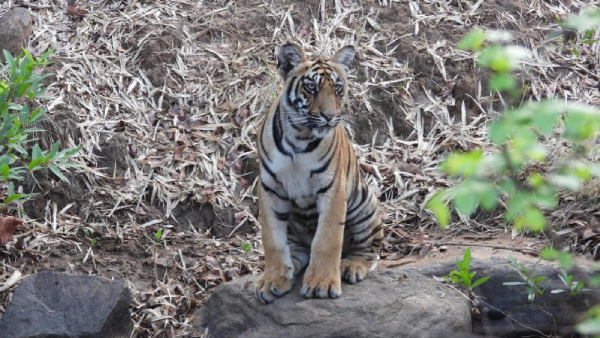Chasing a ‘fifty’ in the jungle for tiger conservation in India
Saturday 29 July 2023
“It’s his breakfast time,” our guide whispered. On a fine morning in the Tadoba Andhari Tiger Reserve, our jeep came in proximity of a tiger, mere steps away, its gaze fixed upon us. It was a chilling yet exquisite moment we experienced amidst Tadoba’s wilderness.
Often seen as a symbol of strength and elegance, tigers have long captured our imagination. Be it for their predominant role in sustenance of the jungle or for their significance as our National Animal, tigers carry the essence of our wildlife heritage. However, as we all come across accounts of creatures that once thrived in numbers but have gone extinct now, conservationists and wildlife experts have a similar fateful concern for the regal predator, if not looked after well.
The awareness around tiger conservation dawned upon me in the later part of my playing days. I realized how our busy lifestyle keeps us away from the concerning issues pertaining to nature and its conservation. Although I got the opportunity to be associated with various causes while playing, I believe it is not until we observe the implications ourselves that we get the crux of it.
My tryst with tigers is mostly supplemented by my visits to the tiger sanctuaries including the Tadoba Andhari Tiger Reserve and the Ranthambore National Park, among others. These National Parks, standing as bastions of tiger conservation in Maharashtra and Rajasthan, respectively, amplify the efforts taken by the communities co-existing in the periphery and the forest officials.
Forest reserves also boast of a distinct flora and fauna that keep the ecosystem thriving. One can see Arjuna trees thriving by the riverbeds, and teaks and mahuas beautifying the lanes of the jungle. On one of our visits, we were astonished to learn how tigers convey their strengths to other tigers by clawing on the pale-and-smooth-skinned ‘ghost trees’. This sense of cohabitation among the flora and fauna creates the core of the national parks and forest reserves. Communities navigate life around the peripheries of such diverse ecosystems. Their lives revolve around the livestock and the forest produce.
However, something that strikes me often is the way the children grow amidst the lap of nature and around the habitats of the tiger. This is true for all the communities and tribes living around national parks and forest reserves. They tend to cultivate a deep sense of respect and appreciation for wildlife from an early age. We were once welcomed heartily by an eager bunch of children when we stopped by their school in Tadoba. Their delight was unparalleled upon receiving new books and school kits. Their knowledge around tigers and other animals and birds, at such a tender age, was commendable. Groomed well, this younger generation holds the potential to be more considerate towards tiger conservation. Just one interaction with them is enough to make you realize their eagerness to learn and prosper.
Conservation is anyway not achievable in isolation; it requires unified efforts. Just like cricket, tiger conservation demands teamwork and collaboration. In recent years, we have witnessed dedicated efforts of forest officials, local communities, and various organizations striving to protect tigers and their habitats.
However, it is imperative that we must acknowledge the results brought in by the ambitious ‘Project Tiger’ that started in 1973. Traversing a long way to mark 50 years this year, this is one of those large-scale projects that have made India’s mark globally. The emerging numbers are encouraging for such a challenging project that builds on the principle to safeguard the regal creature. From a near extinct phase to 3000+ as per the latest census, the project paves way for a promising future for the tigers. Recent campaigns like “Saving Our Stripes” by The Times of India commemorating the ‘Project Tiger’ can also generate awareness among the masses. Nevertheless, for the tiger population to thrive and grow, we need more area under forest cover. This can be achieved through Community Nature Conservancies. These help farm lands to generate more revenue from tourism and improve the lives of otherwise impoverished farmers.
Tigers are keystone species, playing a crucial role in maintaining the balance of ecosystems. Their sustenance ensure the survival of the other species as well as the communities, whom we come across on each of our getaways or visits. We must support collective endeavours to bring back the tigers from ‘endangered’ to a ‘thriving’ status. A future where tigers thrive and lead the ecological balance is where our own sustenance will thrive.



